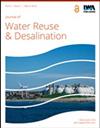减少单户废水回用的反渗透:通过批量开环配置实现低成本分散式卫生设施
IF 2.3
Q2 Environmental Science
引用次数: 5
摘要
低收入国家对水循环利用的需求很大。然而,废水基础设施主要是分散的,因此需要开发负担得起的家庭规模的回收技术。因此,本研究研究了间歇式开环反渗透(RO)系统作为高盐浓缩黑水的低成本清洁水回收途径。在单级配置中,将进料压力从10 bar提高到30 bar,提高了选择性分离,水采收率超过85%,而降低交叉流速提高了产品采收率,将比渗透能量需求从21 kWh m−3降低到4.8 kWh m−3。反渗透膜的总磷(99%)、化学需氧量(COD, 96%)和最终pH值(8.7)均符合ISO30500排放再利用标准。然而,由于低分子量(MW)不带电有机化合物的传输,反渗透膜中总氮的截留不符合再利用标准。建议通过增加进料压力来重新平衡选择性来改善排异,但也可以通过减少流体停留时间(储存)来限制尿素的水解来控制。经济分析表明,高压1812元素成本约30美元符合卫生负担能力指数0.05美元人均- 1天- 1。然而,高压给水泵的单位成本必须降低到约500美元,才能获得负担得起的系统成本。这些单位成本可以通过规模经济制造1812个元件,以及采用为其他需要高压低流量的应用开发的泵送解决方案来实现。总体而言,我们的研究结果表明,批量开环配置中的RO有可能在分散(单户)环境中从黑水中提供负担得起的安全用水。本文章由计算机程序翻译,如有差异,请以英文原文为准。
Downscaling reverse osmosis for single-household wastewater reuse: towards low-cost decentralised sanitation through a batch open-loop configuration
There is a significant demand for water recycling in low-income countries. However, wastewater infrastructure is primarily decentralised, necessitating the development of affordable household-scale reclamation technology. In this study, a batch open-loop reverse osmosis (RO) system is therefore investigated as a low-cost clean water reclamation route from highly saline concentrated blackwater. In a single-stage configuration, increasing feed pressure from 10 to 30 bars improved selective separation at water recovery exceeding 85%, whereas lower cross-flow velocity improved product recovery, reducing specific permeate energy demand from 21 to 4.8 kWh m−3. Rejection achieved for total phosphorous (99%), chemical oxygen demand (COD, 96%), and final pH (8.7) of the RO permeate was compliant with the ISO30500 reuse standard for discharge. However, the rejection of total nitrogen in the RO permeate was non-compliant with the reuse standard due to the transmission of low-molecular weight (MW) uncharged organic compounds. It is suggested that rejection may be improved by increasing feed pressure to rebalance selectivity but may also be controlled by reducing fluid residence time (storage) to constrain the hydrolysis of urea. The economic analysis identified that a high-pressure 1812 element cost of ∼US$30 meets the sanitation affordability index of US$0.05 capita−1 day−1. However, the unit cost of a high-pressure feed pump must be reduced to ∼US$500 to obtain an affordable system cost. These unit costs can be achieved by manufacturing 1812 elements at economies of scale, and by adopting pumping solutions that have been developed for other applications requiring high pressures and low flows. Overall, our findings suggest that RO in the batch open-loop configuration has the potential to deliver affordable and safe water production from blackwater in a decentralised (single-household) context.
求助全文
通过发布文献求助,成功后即可免费获取论文全文。
去求助
来源期刊

Journal of Water Reuse and Desalination
ENGINEERING, ENVIRONMENTAL-WATER RESOURCES
CiteScore
4.30
自引率
0.00%
发文量
23
审稿时长
16 weeks
期刊介绍:
Journal of Water Reuse and Desalination publishes refereed review articles, theoretical and experimental research papers, new findings and issues of unplanned and planned reuse. The journal welcomes contributions from developing and developed countries.
 求助内容:
求助内容: 应助结果提醒方式:
应助结果提醒方式:


